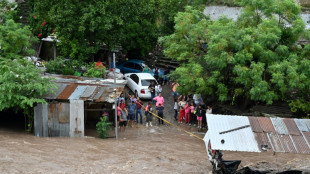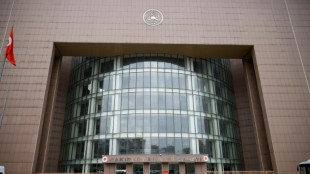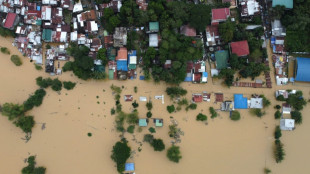
-
 Italy eliminate Swiatek's Poland to reach BJK Cup final
Italy eliminate Swiatek's Poland to reach BJK Cup final
-
Trump expected to attend next Starship rocket launch: reports

-
 Israeli strike on Beirut kills 5 as deadly rocket fire hits Israel
Israeli strike on Beirut kills 5 as deadly rocket fire hits Israel
-
Gvardiol steals in to ensure Croatia reach Nations League quarter-finals

-
 Thousands march to New Zealand's parliament in Maori rights protest
Thousands march to New Zealand's parliament in Maori rights protest
-
China's Xi urges G20 to help 'cool' Ukraine crisis

-
 Church and state clash over entry fee for Paris's Notre Dame
Church and state clash over entry fee for Paris's Notre Dame
-
Holders Spain strike late to beat Switzerland in Nations League

-
 Stocks, dollar hesitant as traders brace for Nvidia earnings
Stocks, dollar hesitant as traders brace for Nvidia earnings
-
Swiatek saves Poland against Italy in BJK Cup semi, forces doubles decider

-
 Biden in 'historic' pledge for poor nations ahead of Trump return
Biden in 'historic' pledge for poor nations ahead of Trump return
-
Sudan, Benin qualify, heartbreak for Rwanda after shocking Nigeria

-
 Five dead in new Israeli strike on Beirut's centre
Five dead in new Israeli strike on Beirut's centre
-
Where's Joe? G20 leaders have group photo without Biden

-
 US permission to fire missiles on Russia no game-changer: experts
US permission to fire missiles on Russia no game-changer: experts
-
Tropical storm Sara kills four in Honduras and Nicaragua

-
 Germany, Finland warn of 'hybrid warfare' after sea cable cut
Germany, Finland warn of 'hybrid warfare' after sea cable cut
-
Spanish resort to ban new holiday flats in 43 neighbourhoods

-
 Hong Kong to sentence dozens of democracy campaigners
Hong Kong to sentence dozens of democracy campaigners
-
Russian extradited to US from SKorea to face ransomware charges

-
 Phone documentary details Afghan women's struggle under Taliban govt
Phone documentary details Afghan women's struggle under Taliban govt
-
G20 wrestles with wars, 'turbulence' in run-up to Trump

-
 Kane hoping to extend England career beyond 2026 World Cup
Kane hoping to extend England career beyond 2026 World Cup
-
Gazans rebuild homes from rubble in preparation for winter

-
 'Vague' net zero rules threaten climate targets, scientists warn
'Vague' net zero rules threaten climate targets, scientists warn
-
Stocks, dollar hesitant as traders eye US rate outlook, Nvidia

-
 G20 wrestles with wars, climate in run-up to Trump
G20 wrestles with wars, climate in run-up to Trump
-
'Agriculture is dying': French farmers protest EU-Mercosur deal

-
 Beyonce to headline halftime during NFL Christmas game
Beyonce to headline halftime during NFL Christmas game
-
Rescuers struggle to reach dozens missing after north Gaza strike

-
 Russia vetoes Sudan ceasefire resolution at UN
Russia vetoes Sudan ceasefire resolution at UN
-
G20 host Brazil launches alliance to end 'scourge' of hunger

-
 Stocks, dollar hesitant as traders scale back US rate cut bets
Stocks, dollar hesitant as traders scale back US rate cut bets
-
Trump confirms plan to use military for mass deportation

-
 Schools closed in Beirut after deadly Israeli air raid
Schools closed in Beirut after deadly Israeli air raid
-
Anger, pain in Turkey as 'newborn deaths gang' trial opens

-
 Kremlin says Biden 'fuelling' war as Russian strikes rock Odesa
Kremlin says Biden 'fuelling' war as Russian strikes rock Odesa
-
UN climate chief at deadlocked COP29: 'Cut the theatrics'

-
 G20 leaders gather to discuss wars, climate, Trump comeback
G20 leaders gather to discuss wars, climate, Trump comeback
-
Stocks, dollar mixed as traders scale back US rate cut bets

-
 Stoinis lets rip as Australia crush Pakistan for T20 series whitewash
Stoinis lets rip as Australia crush Pakistan for T20 series whitewash
-
Bentancur banned for seven games over alleged racial slur

-
 Kremlin says Biden 'fuelling' tensions with Kyiv missile decision
Kremlin says Biden 'fuelling' tensions with Kyiv missile decision
-
COP host Azerbaijan jailed activists over 'critical opinions': rights body

-
 Composer of Piaf's 'Non, je ne regrette rien' dies aged 95
Composer of Piaf's 'Non, je ne regrette rien' dies aged 95
-
South African trio nominated for World Rugby player of year

-
 'Not here for retiring': Nadal insists focus on Davis Cup
'Not here for retiring': Nadal insists focus on Davis Cup
-
Tractor-driving French farmers protest EU-Mercosur deal

-
 Floods hit northern Philippines after typhoon forces dam release
Floods hit northern Philippines after typhoon forces dam release
-
Pakistan skittled for 117 in final T20 against Australia


NATO troops face chill of combat in Arctic exercises
Thousands of NATO troops, some with little experience of operating in snowy conditions, are learning to survive and fight in freezing temperatures in exercises above the Arctic Circle.
Up in Norway's Far North, a group of US Marines have swapped their usual desert camouflage outfits for mountain gear, thick mittens and big white boots.
It is a world away from the hot and humid climate of their home base of Camp Lejeune in North Carolina.
Lying in the snow on the roadside, the men and women of the Marines 2nd expeditionary force are keeping an eye on a fictitious enemy.
They're providing cover for an extensive landing operation on the shore down the hill.
One after another, amphibious Snowcats emerge from the belly of the Rotterdam, a mammoth Dutch landing vessel. Once on the beach, each one in turn unloads tracked vehicles and other military equipment.
"If a unit can train and win in the Arctic, I believe they can win anywhere", says Sergeant Samuel Whitehead.
But here, more than anywhere, he adds, the smallest mistake can have dire consequences.
A few days earlier, four US Marines were killed during the exercise in a plane crash in mountainous terrain, a harsh reminder of the risks of operating in challenging weather conditions.
- Planned before Ukraine -
This month's Cold Response 2022 exercise in Norway is aimed at testing the ability of NATO members -- and non-members Sweden and Finland -- to come to the aid of another member state in difficult climate conditions.
Some 30,000 troops are taking part in the air, sea and land exercises, the biggest manoeuvres Norway has organised since the end of the Cold War.
Planned long in advance, the exercise has taken on added significance following Russia's invasion of Ukraine.
The message we are sending, one US marine confided, is: Don't mess with us -- though he found a blunter way of putting it.
"Many soldiers have been here several times over the years, so they have the right equipment, they have the understanding and the experience ... to fight under winter conditions," says German General Jorg Vollmer, tasked with securing NATO's Northern flank.
"And those who have not had the chance so far, that's exactly the reason why they are here and why they are training", he adds.
In contrast to the dramatic scenes often played out in war films, the only spectacular thing about today's landing operation is the scenery.
In the distance, snowy peaks rise up from the untouched tranquility of the Lofoten archipelago. There are no live rounds fired, no thundering artillery.
The only thing disturbing the silence is the occasional whirring of the helicopter blades.
- Out of your comfort zone -
On the landing craft, soldiers test the water's depth with large sticks before allowing the vehicles to disembark.
A little further away, a soldier stands guard near a white building on which a mural features a man and woman in red capes, fists raised in the air, above the words "Superhero Village".
Katie Hass, who hails from the warmer climes of the southern US, is in charge of the vehicle fleet for a Marines platoon.
Driving for the first time on treacherous icy roads was a step outside her "comfort zone", she said.
"Where we're from, it's hot and swampy versus here in Norway (where) it's cold and snowy and there's ice everywhere", she says.
"There're so many more factors that we need to think of versus what we would think of back home.
"The different fuel that we use here, the different lubricants that we use here, the weight variations between what we can load back home and what we can load to go over the snow and the ice..."
Sergeant Whitehead meanwhile has a tip for his troops more accustomed to dealing with the heat back home.
"Any time you get cold, always keep moving. You'll see Marines, they'll get a little cold and they'll stay stationary. You've got to get them to run around and move around."
P.Smith--AT
